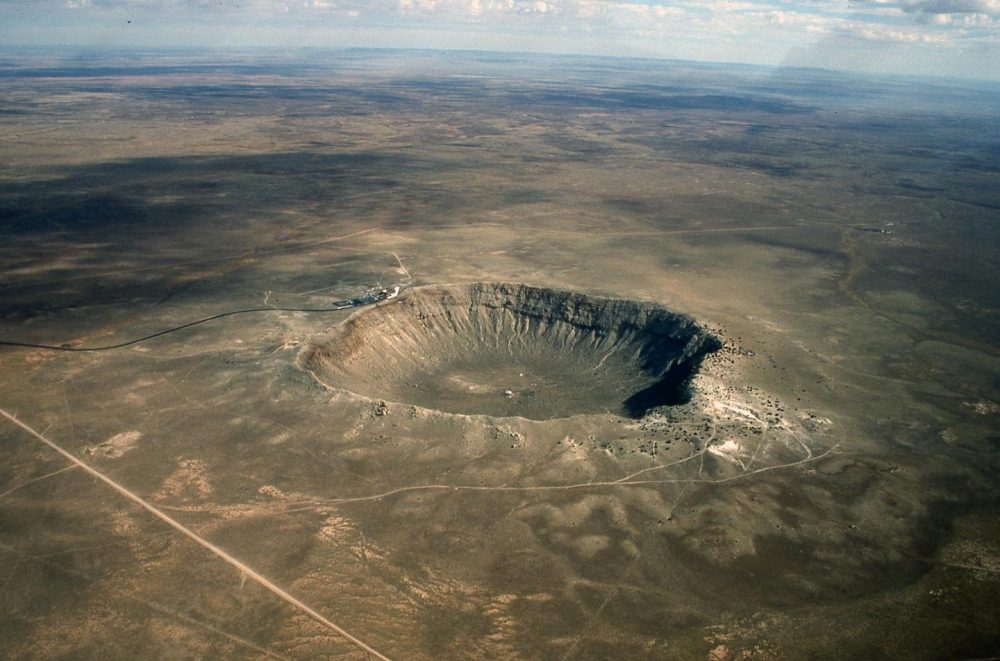The impact crater is believed to have been caused by a massive asteroid measuring around 400 meters in width. Curiously, scientists say it collided with our planet 66 million years ago – around the same time as the Chicxulub asteroid destroyed dinosaurs.
Under the north Atlantic ocean, researchers have found evidence of an asteroid impact crater measuring around 8.5 kilometers. The crater is buried 300-400m below the seabed 400km off the coast of Guinea, west Africa.

According to scientists from Heriot-Watt University, the crater was caused by an asteroid 400m wide colliding with Earth 66 million years ago – around the same time as the Chicxulub asteroid destroyed dinosaurs.
The only way to prove their theory is to drill into the seabed and collect samples. If it is confirmed, the crater will be one of less than 20 marine impact craters found on Earth.
By studying seismic reflections from the Atlantic seabed, geologist Uisdean Nicholson of Heriot-Watt University in Edinburgh discovered the crater.
NEWSLETTER
Never miss a news release from the Curiosmos team.
Despite interpreting seismic data for years, Dr. Nicholson had never encountered anything quite like this. Under the seabed, the researcher observed a depression of 8.5km in place of the flat sedimentary sequences he expected on the plateau. Several characteristics point to an asteroid. Large impact craters typically have a raised rim and a prominent uplift in the center.
Furthermore, it has very chaotic sedimentary deposits extending tens of kilometers from the crater, which appear to be ejecta. According to the researcher, the characteristics are not consistent with processes that form craters, such as salt withdrawal or volcano collapse.
A nearby seamount inspired Nicholson to name the crater Nadir.
According to the experts, the asteroid impact coincides with the dinosaur-killing asteroid crashing off the coast of present-day Mexico.
Additionally, seismic data indicates that the sediments impacted by the asteroid coincide with Cretaceous-Paleogene boundaries. The seismic data resolution, however, leads to some uncertainty.
The team believes the newly-discovered Nadir crater was created when a much larger asteroid broke apart or an asteroid flux at the time.

A meteor crater in Arizona formed as a result of an impact of a 50-meter meteor. When you consider that the bodies that hit Earth, according to studies were city-sized asteroids, where are the remains of these massive impacts? Credit: Dr. Dale Nations, AZGS.
Cretaceous–Paleogene Extinction
Dr. Sean Gulick, an impact expert at the University of Texas at Austin, said: “The Nadir Crater is an incredibly exciting discovery of a second impact close in time to the Cretaceous–Paleogene extinction.”
Even though its size is much smaller than the extinction-causing Chicxulub impactor, its existence indicates the possibility of an impact cluster in the latest Cretaceous. Only 200 impactors have been discovered despite four billion years of impactors hitting Earth. The researcher pointed out that finding new potential impacts is exciting news, especially when it comes to the hard-to-explore marine environment.
In order to determine the type and effect of the collision, the scientists used computer simulations.
“Our simulations suggest this crater was caused by the collision of a 400m-wide asteroid in 500-800m of water,” said Dr. Veronica Bray, a planetary scientist at the University of Arizona.
As a result, a tsunami of over a kilometer height would have been generated, as well as an earthquake of magnitude 6.5 or higher. It is estimated that the released energy would have been around 1000 times greater than that of the volcanic eruption and tsunami in Tonga in January 2022.
The simulations are preliminary and require refinement once more data are available, but they provide important insights into the possible ocean depth in this area at the time of impact.
Nicholson has applied for funding to drill in and confirm that the crater is the result of an asteroid impact and to determine its exact age.
The discovery of the impact crater is reported in a study published in Science Advances.
© 2022 Petri Pixel. All rights reserved. This material may not be published, broadcast, rewritten or redistributed without permission.





